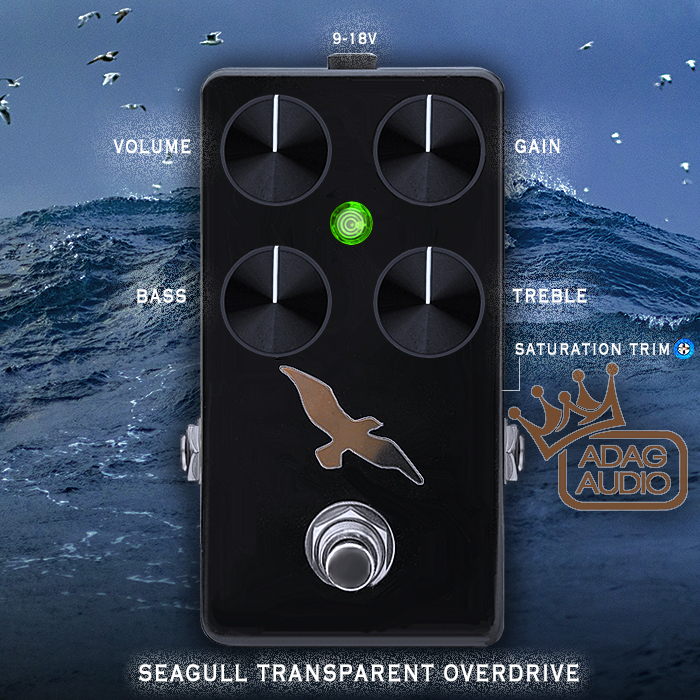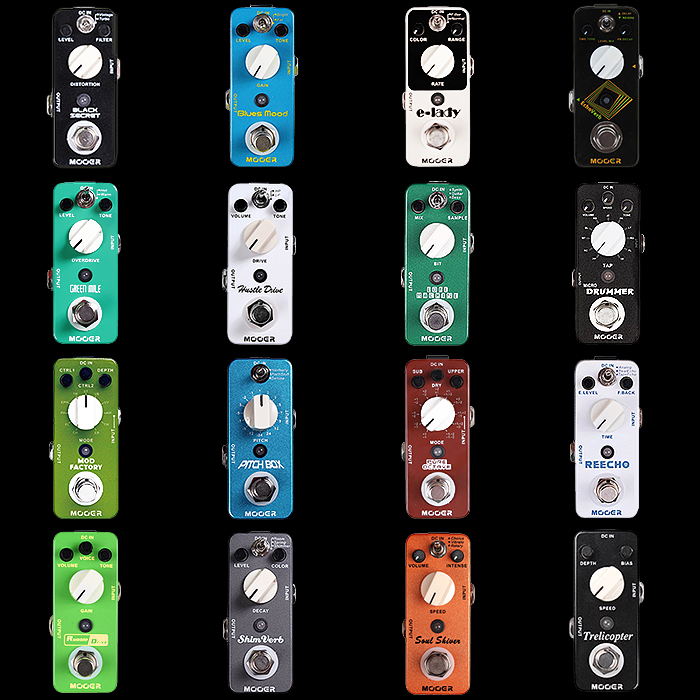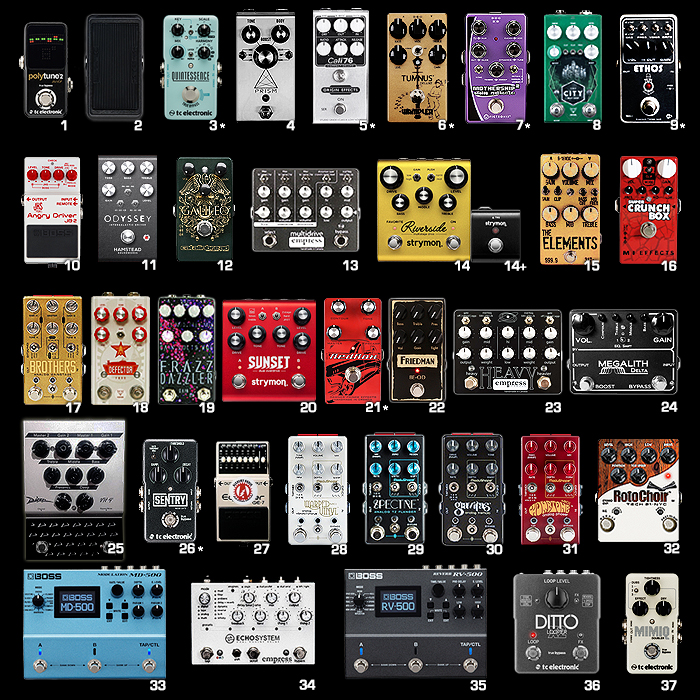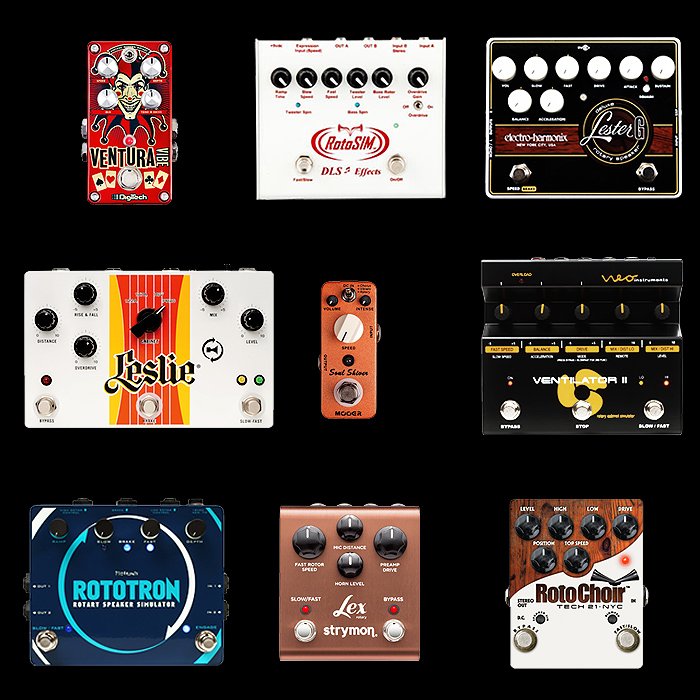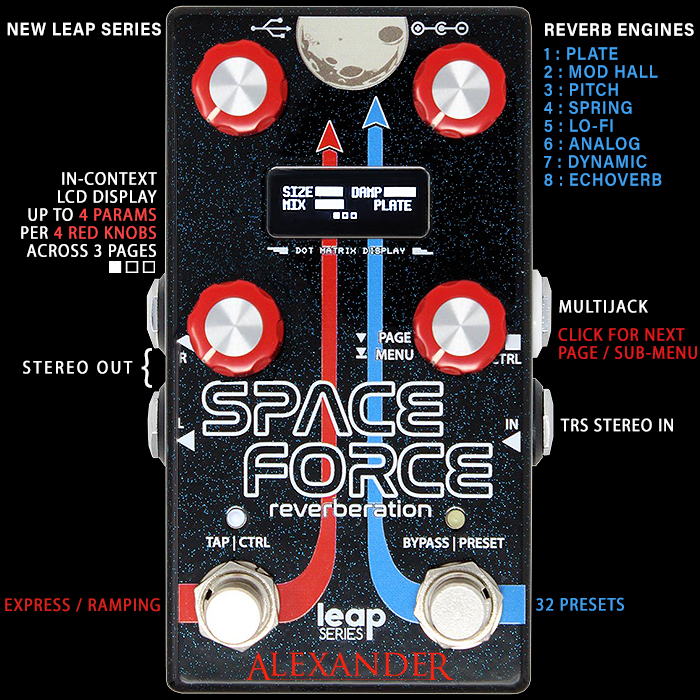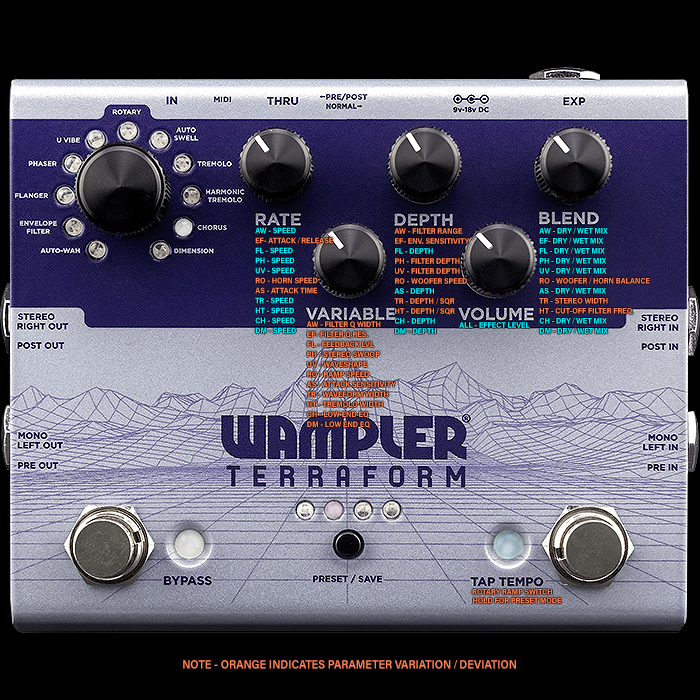Sizing Up Guitar Effects Pedals - Modulation, Delay and Reverb

I have written at length about Overdrive, Distortion and Fuzz pedals - so we now switch our attention to the slots at the tail-end of the pedal chain, which for me are occupied by the 3 Strymon biggies - Mobius, Timeline and BigSky. And unlike the various drive pedals - where I have numerous options and reserves, with those Strymons I really have everything I need in the area of after-effects. In fact the only swap out I currently have here is an MXR Phase 95 Mini - in the modulation category.
I often consider what I would have done with a tighter budget and a greater restriction on footprint / pedal size. And the resulting train of thought is this particular blog post. It also depends very greatly on what is available at your time of purchase. There are two fairly recent best-selling pedals in this picture that were not released when I procured the Strymons, and one brand new one that has yet to be released - more of that later.
Mini Pedals
I already have a few Mooer pedals, and you pretty much know what you’re getting - which is largely really good quality at a pretty low price. No longer priced quite as low as other newer Chinese competitors like Tone City, Mooer still retain an edge for amazing features and decent sound quality at the more budget end of the scale - and particularly at the mini size. A number of pro players include a Trelicopter or Shimverb at the end of their boards as specialist effect ’toppers’. And were I restricted by budget and size then the 3 mini pedals pictured would be the ones I would go for in those categories:
- Modulation : Mooer Mod Factory - 11 Effects : Chorus | Flanger | Phaser | Envelope Phaser | Tremolo | Stutter | Vibrato | Univibe | Auto Wah | Touch Wah | Envelope Ring
- Delay : Mooer Reecho - 3 Effects : Analog | Real Echo | Tape Echo
- Reverb : Mooer Shimverb - 3 Effects : Room | Spring | Shimmer
A similar philosophy influences why I picked these Mooers versus say obvious swap-outs - like Mini TC Electronic Pedals - Flashback or Hall of Fame. Namely all the settings are there on the pedal and you have multiple options you can quickly switch to - directly on the control panel - in this instance 3 alternative effects voicings.
The TC Electronic Tone Print pedals have the advantage that you can download any number of presets - but you are limited to hosting one at a time - with just a single control knob for on-the-fly tweaking. With the Mooers you can switch between different effects and tweak a couple of the parameters on the fly - which will always be my preference. I really like the option of hands-on control being ever-present -even with some of the more advanced pedals which rely on secondary connected apps.
Regular Pedals
This is an area that used to be ruled by Boss and MXR, but they largely tend to stick to fairly singular functions per pedal, although both do have excellent alternatives for Delay and Reverb - with multiple options.
TC Electronic do things just a little bit smarter though - particularly for their Flashback and Hall of Fame pedals which include ’TonePrint’ capabilities for presets. Originally I had 3 TC Electronic (TCE) pedals here, I had almost forgotten about the Neunaber Immerse which Rob Chapman likes so well. But any of the regular-sized TCE reverb pedals - Hall of Fame, Arena or T2 are good alternatives, the Neunaber Immerse just about pips it for this slot though (we must also not forget the TCE Alterg Ego V2 Vintage Echo):
- Modulation : TC Electronic Dreamscape - 7 Effects : Chorus 1 | Flanger 1 | Vibe 1 | Chorus 2 | Flanger 2 | Vibe 2 | TonePrint preset
- Delay : TC Electronic Flashback - 11 Effects : 2290 | Analog | Tape | Lo-fi | Dynamic | Modulation | Ping Pong | Slap | Reverse | Loop | TonePrint preset
- Reverb : Neunaber Immerse - 8 Effects : Wet | Hall | Plate | Spring | Shimmer A | Shimmer B | Echo | Detune
It’s usually a combination of feature set, versatility and sound quality that win out, not necessarily which one gives you the largest variety - as some of those may be mediocre, as is the case for a few settings on the Mooer Mod Factory. For these regular-sized pedals you get excellent sound quality and a pretty decent feature set, albeit lacking things like touch-tempo that the larger pedals have.
There really is very little choice in a regular-sized all-round modulation pedal, the closest I could find was this TCE John Petrucci signature pedal - which does though have a 7th TonePrint preset option that you can load with a Tremolo sound or other unique preference. There really is an opening in the market for both TC Electronic and Neunaber to offer a more versatile regular size modulation pedal. It should also be mentioned that there are some regular-sized pedals coming through from Fox Pedals which manage to accommodate second touch-tempo footswitch on the chassis - so those may deserve a look-in when fully launched later in the year
Medium Pedals
When the Source Audio Nemesis came out, I suffered just a touch of post-purchase dissonance, as it may have shaped my buying habits differently had it been available when I bought wholesale into Strymon. The reason I liked the Strymons so much is that you have 200-300 presets you can dial in yourself, and the pedals already come loaded with 100 existing preset sounds - which you can access and switch between on=the-fly using the pedals’s combinations of 3 foootswitches. Everything is available on each pedal and it can all be dialled in using the various pedal dials and main control panel / values knob.
The Nemesis has only a limited amount of presets on the pedal, and none are preconfigured as I understand. You get 12 Delay engines on the pedal and 12 more you can download via the Source Audio Neuro App. In fact the Neuro App provides a constant upgrade path where you can upgrade patches and download new and improved sounds to your pedal. Moreover, Source Audio have configured the control dials very cleverly so that everything is available right on the surface of the pedal - you don’t have to dive into sub-menus to access certain parameters, although these are available on the App.
So there are pros and cons with the Nemesis, a significant pro being that it is almost half the size of the equivalent Strymon. Some pros prefer the Strymon TimeLine still, although some have switched over to the Nemesis. I certainly would like to acquire one for side-by-side testing at some stage, and I would love to have it as a backup / reserve to the Strymon - both are really great pedals and near the top of the tree as such.
The Eventide H9 Harmonizer is an interesting beast which combines all the effects of its larger pedals - the ModFactor, PitchFactor, TimeFactor and Space - if you buy the ’Max’ version you get access to the whole library through one pedal - via 500 available presets. In the pedal line-up I am using this more for its Mod- and PitchFactor effects, but it also has amazing Delay and Reverb options - so can replace any of the three pedals featured in the above pic. This pedal works best through an external midi control pedal, and there are limited opportunities to tweak on the fly - unlike with the Source Audio or Strymon pedals.
Everyone is eagerly awaiting the imminent arrival of the Ventris Reverb pedal - which although it looks similar to the Nemesis, will allow for dual simultaneous reverbs, again from 12 onboard engines and more available from the Neuro App.
Here follow my preferred pedals at this size:
- Modulation : Eventide H9 Max - 500 onboard presets : pretty much every Modulation, Delay and Reverb sound you might need in one pedal
- Delay: Source Audio Nemesis - 8 onboard presets, 12 / 24 Engines : Slapback | Digital | Diffuse | Analog | Tape | Noise Tape | Degrade | Shifter | Helix | Reverse | Sweeper | Rhythmatic
- Reverb : Source Audio Ventris - 8 onboard presets, 12 / 24 Dual Engines : Modverb | Room | Club | Stage | E-Dome | Plate | True Spring | Shimmer | Swell | Lo-Fi | Vocal | Metal Box
Large Pedals
So I’ve largely already voiced the decision process in selecting Strymon, and I still consider it the right choice - even though I would like to add the two Source Audio pedals and the Eventide H9 Max for even greater versatility at some stage, I must say that you can’t really go wrong with Strymon - yes there is quite a steep learning curve initially, but it is all common sense really once you get into it - and as with any pedal - you will need to tweak anyway - I specifically have knee-pads for just such a purpose!
I sometimes think that these Strymon pedals could benefit from an App - a la Source Audio and Eventide - to ease dialling in of presets, and allow for easy updates and upgrade - also ability to upload ToneCloud / TonePrint - like sounds. With Strymon you need to look up say U2 delay preset and dial it in yourself. The sound though is immense and quite superb. I have convinced myself that the Strymons are the right balance of versatility and accessibility - I totally love the fact that I can easily stomp between presets using the footswitches alone - this is where the Strymon and larger Eventide -Factor pedals really come into their own.
There are so may advantages to using the large Strymon pedals, that even though the other competitors have merits, overall Strymon just wins out so far. Strymon also has by far and away the best documentation and readily available resources right from their website’s product pages.
It almost goes without saying that apart from the various Eventide pedals mentioned, the Strymon pedals are the dearest of the lot, in fact the price very closely correlates to size typically, with few exceptions - in that the smaller the pedal the cheaper, and the larger the dearer:
- Modulation : Strymon Mobius - 200 onboard presets, 12 Engines : Chorus | Flanger | Rotary | Vibe | Phaser | Filter | Format | Vintage Trem | Pattern Trem | Autoswell | Destroyer | Quadrature
- Delay : Strymon TimeLine - 200 onboard presets, 12 Engines : dTape | dBucket | Digital | Dual | Pattern | Reverse | Ice | Duck | Swell | Trem | Filter | Lo-Fi
- Reverb : Strymon BigSky - 300 onboard presets, 12 Engines : Room | Hall | Plate | Spring | Swell | Bloom | Cloud | Chorale | Shimmer | Magneto | Nonlinear | Reflections
There are some very obvious swap-outs for the Strymons, including almost like-for-like Eventide -Factor pedals and Empress Nebulus, Echosystem and Reverb pedals. The smaller Source Audio pedals are definitely in the frame too, as well as a couple of Pigtronix Pedals - like the Echolution 2 Ultra Pro.
There are new pedals arriving all the time, and each brings innovations and improvements. For me, and based on my current mindset, Strymon is still king, and I still need to acquire a few more of their pedals for more specialist uses, I also really like the Nemesis and Ventris, and some of the Eventide sound library is peerless - which means an H9 Max is likely needed at some stage too.
Postscript
I’ve already mentioned that I am interested in acquiring a Bitcrusher - currently torn between a BitQuest and a Frantabit, then I would quite like a Strymon Lex and Strymon Flint - the former for more specialist rotary sounds, and the latter for more tweakable Tremolo + Reverb combinations. I have already mentioned that I am awaiting the updated Diezel 2 Channel VH4 pedal, and also like the look of the Wampler Dracarys. As far as this subject matter goes, next likeliest acquisitions for after-effects will either be the 2 Source Audio pedals or the H9 Max - which funnily level out at the same cost or 2 for 1 roughly.
I was kind of in the market for a 3rd guitar too, seeing as one is permanently tuned to Periphery Drop C - CGCEGD. Yet I am having trouble weighing up new guitar against new pedal needs. Right here right now, I am more inclined to expand the pedal / sound / fx library. I have several goals already in mind, which will likely mean no additional guitar this year...
Post Postscript
In addition to voicing my admiration of Source Audio and Eventide Pedals - i.e. Nemesis, Ventris and H9 Max. I am increasingly impressed by Empress too - particularly the new EchoSystem Dual Delay. My current thinking is that the Dual Empress EchoSystem plus the Dual Source Audio Ventris will give the most versatility. I inadvertently left out mention of the highly versatile Mooer Ocean Machine - which allows you to apply two delays and one reverb simultaneously - still the best bang for you buck for versatility. The Empress + Source Audio route will be more than twice as expensive, but you end up with a system of two separate delays plus two separate reverbs - for totally amazing permutation potential - particularly for ambient players.
I am intrigued to see how Strymon reacts to this - will it launch a dual-processor version of its own? One of the factors that is of increasing importance for me is ease of use - that is not just the ease of dialling in a sound, but the ease of dialling in something that sounds great, can be saved as a preset and quickly alternated / switched out for full playback versatility. The Empress’s 35 presets are probably about right for how many you might need for a full set. Strymon really needs to up its game now - by introducing dual ability - as well as enabling easy update of firmware and presets. Empress’s use of multiple different colour LEDs to indicate different options is genius - and far more intuitive than what the Source Audio pedals do at the moment. Strymon’s and Eventide’s LED displays of course go one further - I feel Empress could easily have had just a 2 or 3 digit display. But it does retain a great elegance in look sans display.
I am also mindful of how clever the stomp buttons on the Line 6 Helix are - where you can apply text values to the individual stomp buttons. For Strymon you could ideally do with a couple more dials and have them all digitally labelled up - and switched to a different colour when in secondary mode etc. This would of course all add expense to the price, but would make the pedals more intuitive and learnable for newbies...









